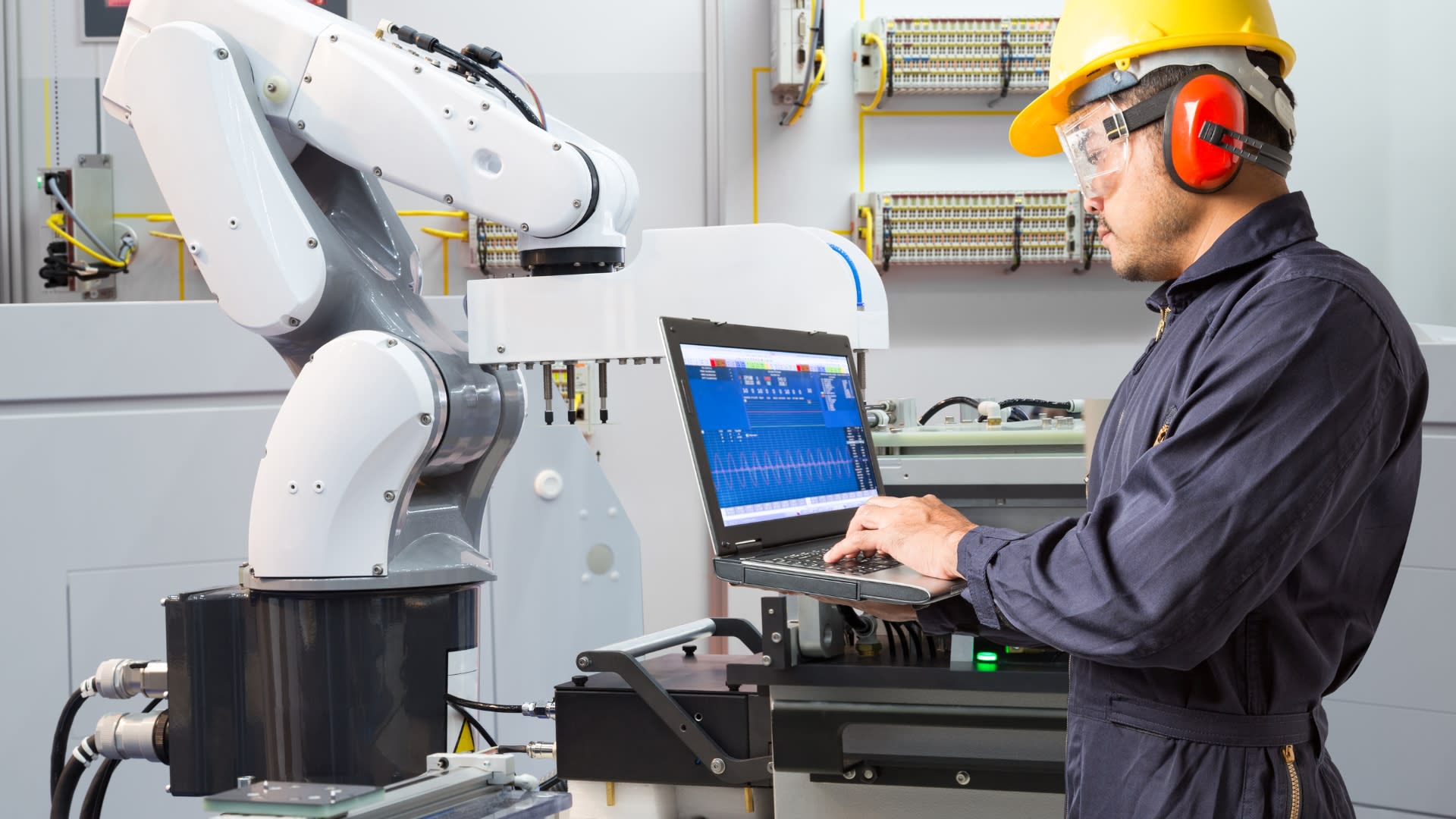Industrial Robotics Market Poised to Reach $55.19 Billion by 2033

According to Renub Research Latest Report Industrial Robotics Market is projected to reach USD 55.19 billion by 2033, up from USD 28.11 billion in 2024, registering a CAGR of 7.79% between 2025 and 2033. This robust growth is fueled by increasing automation adoption across industries, continuous technological advancements, and rising demand for precision, safety, and efficiency in manufacturing processes.
Industrial robots are transforming the manufacturing landscape by performing complex tasks such as welding, painting, assembling, and material handling. The adoption of robots is particularly strong in sectors such as automotive, electronics, metal and machinery, food and beverage, and pharmaceuticals. Companies worldwide are leveraging robotics to remain competitive, reduce labor costs, enhance productivity, and operate safely in hazardous environments.
Industrial Robotics Industry Overview
Recent innovations in automation technology, artificial intelligence (AI), and machine learning (ML) have accelerated the industrial robotics market. Robots are increasingly integrated into manufacturing lines, supporting not only efficiency but also quality control and operational safety.
Advanced sensor technologies and the rise of collaborative robots (cobots), which work alongside humans, have expanded the versatility of industrial robots. Integration with Internet of Things (IoT) systems and AI is making robots essential to modern supply chain management, smart factories, and Industry 4.0 implementations.
Globally, governments and businesses are investing heavily in automation. For instance, China’s “Made in China 2025” initiative aims to modernize manufacturing through innovation-driven, high-quality production. Collaborative robots are expected to account for 34% of all robot sales in 2025, according to the International Federation of Robots (IFR), signaling widespread adoption across multiple sectors.
Companies like Foxconn are leveraging industrial robotics to enhance production efficiency, while semiconductor manufacturers rely on robots to meet the growing demands of precision and consistency. Overall, robotics adoption is no longer limited to traditional manufacturing; industries such as logistics, food processing, and life sciences are also increasingly integrating robotic systems.
👉 Want to explore detailed market trends, segment insights, and forecasts? 🔗 Request Sample Report
Key Growth Drivers
1. Automotive Industry Expansion
The automotive sector remains the largest adopter of industrial robots, particularly for welding and painting operations. Robots ensure high accuracy, repeatability, and structural integrity in manufacturing processes. For example, Volvo Cars utilized over 1,300 ABB robots across its China and Sweden plants in 2023 for spot welding and riveting.
Additionally, automotive painting has become highly automated. BMW implemented an AI-controlled robotic painting system in 2023 to improve quality, reduce lead times, and enhance surface inspection processes. These innovations continue to drive the industrial robotics market forward.
2. 3D Printing and Additive Manufacturing Integration
Industrial robotics is increasingly combined with 3D printing and additive manufacturing (AM). Robots equipped with extrusion or deposition heads can manufacture complex components using metals, ceramics, and thermoplastics. For example, ADDitec’s AMDroid laser-wire DED robotic system, introduced in 2023, supports high-deposition-rate production, particularly with titanium.
Similarly, RIC Technology introduced the RIC-M1 PRO robotic printer for large-scale construction in 2024, allowing automated production of walls and panels. These innovations in AM are driving adoption of industrial robots beyond conventional manufacturing processes.
3. Industry 4.0 Adoption
The Industry 4.0 revolution emphasizes automation, data connectivity, and real-time monitoring, boosting industrial robotics demand. Modern robots are networked to seamlessly integrate with other devices and control systems. For example, KUKA AG launched the KR FORTEC robot in 2024, featuring a 145-inch reach and 529-pound payload, ideal for welding and material handling.
Human-robot collaboration is also gaining traction. Cobots enable humans to focus on complex tasks while robots handle repetitive processes, improving safety and productivity. Partnerships like Figure and BMW in 2024 to deploy humanoid robots further highlight the market’s growth potential.
Market Challenges
Despite promising growth, the industrial robotics market faces several challenges:
1. High Initial Costs
Industrial robots involve substantial upfront costs, including purchase, installation, calibration, and ongoing maintenance. For small and medium-sized enterprises (SMEs), these costs can limit adoption, despite long-term productivity benefits. Integration with existing systems and the need for specialized technical expertise further increase expenses.
2. Skilled Labor Shortages
A shortage of trained professionals capable of programming, operating, and maintaining robotic systems is a significant challenge. The rapid growth of robotics adoption has outpaced the availability of skilled workers in automation and AI, creating a skills gap. Companies are investing in training programs and partnerships with educational institutions to build a capable workforce.
Regional Market Insights
United States
The U.S. industrial robotics market is expanding due to Industry 4.0 adoption, rising efficiency demands, and innovation-driven automation. Cobots are increasingly deployed for safer human-robot collaboration. Government incentives for modernization and labor efficiency further drive market growth, although high upfront costs and skilled labor shortages remain obstacles.
United Kingdom
The UK market is growing across electronics, pharmaceuticals, and automotive sectors. Cobots are enhancing productivity and safety, while automation reduces labor costs. Government programs supporting digital transformation and advanced manufacturing encourage robotics adoption. However, adoption is limited by high costs, training requirements, and job displacement concerns.
China
China represents one of the largest and fastest-growing markets for industrial robotics, driven by its manufacturing dominance and initiatives like “Made in China 2025.” Cobots are widely adopted, improving efficiency and reducing labor costs. Integration with existing manufacturing systems, high initial investment, and workforce skill gaps remain challenges.
United Arab Emirates
The UAE is investing heavily in automation to diversify its economy and improve manufacturing productivity. Robotics adoption spans construction, logistics, and automotive sectors, supported by initiatives like UAE Vision 2021. Cobots are enhancing safety and efficiency, but high costs and technical integration challenges limit wider adoption.
👉 For deeper analysis, detailed segment data, and company insights: 🔗 Request Customization Report
Market Segmentation
The industrial robotics market is segmented by industry, geography, and key players:
By Industry:
Automotive Industry – welding, painting, assembly.
Electrical & Electronics Industry – precision assembly, testing.
Metal & Machinery – material handling, cutting, shaping.
Plastic & Chemical Products – packaging, molding.
Food Industry – processing, packaging, palletizing.
Others – logistics, pharmaceuticals, life sciences.
By Geography:
Americas: U.S., Canada, Mexico, Others.
Europe: France, Germany, Italy, Spain, Others.
Asia-Pacific: China, India, Japan, South Korea, Thailand, Others.
Rest of the World
Key Players:
KUKA
iRobot Corporation
Intuitive Surgical, Inc.
Panasonic Corporation
Fanuc
ABB Ltd
Stryker Corporation
Companies are focusing on strategic collaborations, AI-driven innovations, and expanding automation applications to maintain a competitive edge in the rapidly evolving market.
Outlook and Future Trends
The industrial robotics market is expected to continue growing steadily through 2033. Key trends include:
Increased Cobot Adoption: Collaborative robots will account for an even larger share of industrial automation, particularly in SMEs.
AI and IoT Integration: Enhanced connectivity will enable predictive maintenance, real-time monitoring, and smarter production lines.
Sustainable and Energy-Efficient Solutions: Manufacturers are developing low-energy robots and environmentally friendly automation technologies.
Expansion into Emerging Markets: Rising industrialization in regions such as Southeast Asia, the Middle East, and Latin America will fuel new adoption opportunities.
In conclusion, industrial robotics is playing a transformative role in global manufacturing. Driven by technological innovation, Industry 4.0 adoption, and growing automation needs, the market is poised for sustained expansion. Companies investing in advanced robotics, skilled workforce development, and strategic partnerships are likely to emerge as leaders in this rapidly evolving industry.
Note: If you need details, data, or insights not covered in this report, we are glad to assist. Through our customization service, we will collect and deliver the information you require, tailored to your specific needs. Share your requirements with us, and we will update the report to align with your expectations.
link






